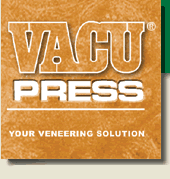Don Stephan

Posts: 825
Joined: 2003-07-18
Location: Cincinnati, Ohio
 User Profile User Profile |
If I seemed unencouraging in the last post, my apologies - it certainly wasn't intended.
From your description of the Heatlock adhesive, I assumed its usual use is to apply to the substrate and veneer, let partially dry, then lay the veneer onto the veneer and activate the two layers of Heatlock (and adhere the veneer to the substrate) by applying heat from an iron.
Lots of people have done this, with acceptable results, but I think they generally are working one of two situations:
adhering veneer to a flat surface, such as the side or top of a box, and
adhering edging (typically 1-2" wide) to the edge of a table, which may be rectangular or round.
When iron-activating adhesive on a two-dimensional flat surface (such as the side of a box or the edge of a rectangular table) there is good contact with the flat bottom of the iron. When iron-activating adhesive on the edge of a round table there is only contact between the (hot) bottom of the iron and the table edge along a narrow vertical strip so it can be slightly more challenging to heat a section of the curved table edge uniformly without overheating. But the contact area of the iron presses the veneer into the activated adhesive as one works along the edge.
Veneering a table apron would be very similar to edge veneering a round table, except that the apron would be 3-4" wide where the table edge would be 1-2" wide. There is one additional difference as you know, though: the apron has outer and inner surfaces. And for balancing purposes (to maintain the radius of the apron over time) the inside surface should be veneered similarly to the outside surface.
Iron-activating the Heatlock adhesive on the outside or convex side of the apron is identical to the situation with a round table edge - the iron will at any point in time be in contact with a narrow strip of the outer surface but with some patience and uniform movement of the iron the adhesive can be activated and the veneer uniformly pressed into the adhesive.
But on the inner (concave) side of the apron, the iron is only going to contact the veneer along the two edges of the iron. The adhesive will be activated in these two narrow bands and the veneer bonded. But because there is an area of veneer between these two narrow strips that is not being pressed, it is quite possible the veneer will not be contacting the curved apron between these two narrow bands and will have a smaller radius than the apron, meaning the veneer would have to be stretched to contact the substrate. You could try using just the triangular tip of the iron on the back or concave side of the apron, but I don't think it's going to work significantly better.
I think it's going to be very difficult to get a good bond with iron-activated veneer on the inside surface of a curved substrate, but it's just my opinion.
My best advice, no matter what method you decide to use, is to use inexpensive veneer and a similarly curved substrate first and see if the results are acceptable.
|






